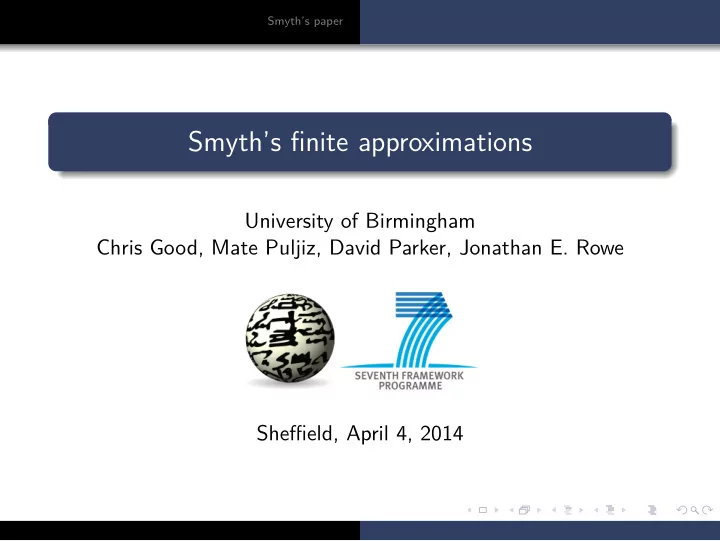

Smyth’s paper Smyth’s finite approximations University of Birmingham Chris Good, Mate Puljiz, David Parker, Jonathan E. Rowe Sheffield, April 4, 2014
Motivation Smyth’s paper Inverse limit construction The End Universality A space is universal for a certain class of spaces if all the spaces from that class can be realised as the quotients of the initial space. It is a well know fact that ω ω is the universal Polish space (complete, metric, separable) and Cantor set is universal for the separable compact metric spaces. Eg, the binary expansion of a real number { 0 , 1 } ω → [0 , 1] .
Motivation Smyth’s paper Inverse limit construction The End Why this may be interesting to us? Going back to the commuting diagram, ˜ f U U Ξ Ξ f X X starting with X we are provided with the map Ξ . If we could lift the map f to a map ˜ f on U then finding CGs of ( X , f ) corresponds to finding CGs of ( U , ˜ f ) that are constant on the level sets of Ξ .
Motivation Smyth’s paper Inverse limit construction The End Problems? Not every Ξ will work. It needs to be tuned with respect to the given f . Eg, the aforementioned binary expansion doesn’t allow lifting of the map x �→ 3 2 x (hence, 1 3 �→ 1 2 ). Can we always find Ξ that allows lifting?
Motivation Smyth’s paper Inverse limit construction The End Construction Inverse system f 2 , 1 f 3 , 2 f 4 , 3 X 1 ← − X 2 ← − X 3 ← − X 4 . . . Inverse limit � lim − X i = { ( x i ) i ∈ X i | f n +1 , n ( x n +1 ) ∈ x n } . ← i
Motivation Smyth’s paper Inverse limit construction The End Construction Given a space X , take a sequence ǫ n ↓ 0 , construct finite (or countable) families of open sets C n st. diameter of each set in C n is less then ǫ n sets from each C n cover X each set from C n +1 is contained in the unique set from C n * image under f of each set in C n +1 is contained in the unique set from C n We think of the sets in C n as symbols. The binding maps are inclusions. Assuming that X has no isolated points, the inverse − C n is homeomorphic to the Cantor set or ω ω depending limit lim ← on whether X was compact or not. And f induces a lifted map ˜ f .
Motivation Smyth’s paper Inverse limit construction The End A different perspective Having constructed U = lim − C n it is clear that the projection Ξ should map ( x i ) i to � x i where x i ∈ C i is a decreasing sequence of ← sets. Also, the map is far from being 1-1 since sets in C i are not disjoint. Rather than constructing an universal covering space and then quotienting it to obtain initial space, Smyth encodes additional information within each finite approximation C i in form of a directed graph with the vertices set C i and with an edge connecting each pair of intersecting sets. This gives rise to a graph structure on the inverse limit. We put edge between ( x i ) i and ( y i ) i iff there is an edge connecting x i and y i for every i .
Motivation Smyth’s paper Inverse limit construction The End A different perspective Note that ( x i ) i and ( y i ) i are connected by an edge iff they represent the same point in X . Hence, space X is now given as an quotient with respect to this relation. The triplet ( X , τ, R ) is a topological graph which captures properties of both topological spaces and graphs. For a topological space one can take R to be the trivial (diagonal) relation, and for a finite graph, the topology is trivial (discrete) and the relation is one given by the graph. Idea is that on top of having a topology, the relation R tells us which are our the closest neighbours of a given point. Using this one can construct a coarser topology on X consisting of only those open sets such that they have their close neighbours inside that set (R-invariant). The intermediate step is taking all such (not just open) sets and that family needs not to form a topology but it is a neighbourhood space .
Motivation Smyth’s paper Inverse limit construction The End This essentially means that graphs are represented as non Hausdorff finite spaces and their inverse limit is a non Hasdorff space whose T 0 quotient is initial space. ǫ - approximation by a finite graph then amounts to taking C n consisting of subsets having small enough diameters. The trouble is that our lifted function is not mapping on C n . It is mapping from C n +1 to C n which means that mapping is increasing our error. After n iterations we will not know where in the space we are.
Motivation Smyth’s paper Inverse limit construction The End The End! Thank you!
Recommend
More recommend